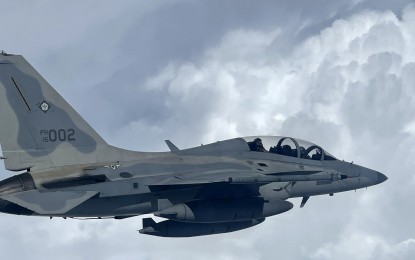
(Photo courtesy of PAF)
MANILA – Philippine Air Force (PAF) FA-50PH jet fighters will conduct "dissimilar air combat tactics" (DACT) with Hawker Hunter aircraft of the US Navy on Friday, the last day of the two-week "Balikatan" exercises.
"The last flight of the FA-50s of the 5th Fighter Wing with the Hawker Hunters of the US Navy will be on April 8, they will do DACT," said PAF spokesperson, Col. Maynard Mariano, in a message to the Philippine News Agency Thursday.
He added that these exercises will have two Korea Aerospace Industries FA-50PH planes going head-to-head with Hawker Hunter transonic aircraft which the US Navy contracted for this purpose.
DACT refers to training where two dissimilar aircraft are pitted against each other in air-to-air combat.
Winners are generally the fighter teams who can successfully manage to get the so-called "simulated kill" via the opposing jet fighters' air-to-air missile or gunnery systems.
Mariano said the FA-50PH and Hawker Hunter aircraft will conduct "four sorties" on the said training.
Aside from the DACT, PAF and participating US air units also conducted defensive counter-air, and offensive counter-air exercises along with tactics in the fighter and missile engagement zones in the past two weeks, the PAF spokesperson added.
"SMEEs (subject matter expert exchanges) and practical exercises were also done for surface-to-air missile employment concentrating on its command-and-control, hand-over of defenses, and employment and deployment planning," Mariano said.
Participating in these exercises are the American Lockheed Martin F-16s "Fighting Falcon" fighter aircraft and the Patriot surface-to-air missile system, and UH-60 "Black Hawk" while the Air Force deployed the FA-50PHs and the anti-aircraft units of the PAF's 960th Air and Missile Defense Group.
"Balikatan" which means “shoulder-to-shoulder” or “shouldering the load together” is an annual joint and combined exercise hosted by the Armed Forces of the Philippines (AFP) and US Indo-Pacific Command conducted to strengthen bilateral interoperability, capabilities, trust, and cooperation built over decades of shared experiences.
Participants in this year's "Balikatan" exercises are 3,800 members of the Armed Forces of the Philippines (AFP) and 5,100 US military personnel -- the largest number of combined personnel of the two militaries in the annual exercise since the start of the coronavirus disease 2019 (Covid-19) pandemic in 2020.
During the "Balikatan" 2021, at least 226 American and 415 Filipino military personnel participated, while "Balikatan" 2020 was canceled due to the Covid-19 pandemic.
PH, US troops hold air assault exercise
Meanwhile, the Philippine Army (PA) and its US Army Pacific (USARPAC) counterparts have conducted an air assault exercise in Fort Magsaysay, Nueva Ecija from April 4 to 5.
"The air assault exercise -- spearheaded by PA and USARPAC (jointly called the Combined Army Forces or CARFOR) -- was highlighted by the seizure of multiple objectives through the company-level combined air assault launched by the PA 1st Brigade Combat Team and USARPAC’s 3rd Infantry Brigade Combat Team, 25th Infantry Division," said Army spokesperson, Col. Xerxes Trinidad, in a statement Wednesday night.
The exercise tested the interoperability of both armies in a holistic exercise that incorporated elements of combined joint special operations forces reconnaissance; chemical, biological, radiological, nuclear, and explosives (CBRNE); counter-improvised explosive device (C-IED); site exploitation; and military operations on urban terrain (MOUT).
Another highlight of the exercise is the nighttime sling load training where soldiers rigged up a piece of equipment onto all-weather, medium-lift "Chinook" and "Black Hawk" helicopters using sling sets, cargo nets, and other specially designed equipment.
Sling loading equipment allows units to avoid obstacles that may hinder them from promptly reaching their target destination. The technique is also used to reach areas where the use of convoys is impractical or unfeasible. (PNA)
